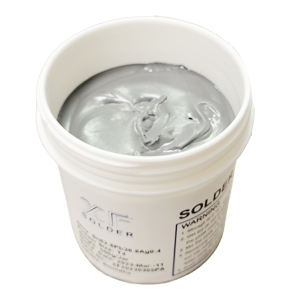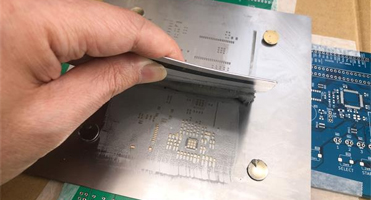

 | Tin Lead Solder Paste Sn60Pb40, comprised of 60% tin (Sn) and 40% lead (Pb), is a widely used soldering material in many applications. It is known as solder paste 60 40 too. This solder paste simplifies soldering processes while ensuring strong connections in various applications.
Sn60Pb40 solder paste is made of solder powder, flux, and binder. It plays a pivotal role in surface mount technology (SMT) and electronics assembly, enabling reliable solder connections. |
Alloy Composition | 60% Tin (Sn), 40% Lead (Pb) |
Melting Point | 183-190°C |
Flux Type | Rosin based flux |
Powder Size | Type 3 (25-45μm), Type 4 (20-38μm) |
Shelf Life | Recommended 6months |
Weight | 500g/jar |
Brand | XF Solder or OEM service |
*We also produce the solder paste in syringe. | |
Packing In Jars | Packing In Syringe |
Lower Melting Point Sn60Pb40 solder paste typically has at 183°C to 190℃. It requires much lower heat than most other leaded solder paste alloy to work with. This characteristic makes it ideal for reflow soldering processes. | Good Wetting Property Solder paste 60 40 has excellent wetting properties, which means it can readily flow and bond with a variety of metal surfaces. It is compatible with a wide range of surface mount components, such as resistors, capacitors, integrated circuits (ICs), and more. | |
Reliable Solder Joints When properly applied, it creates strong solder joints with good electrical and thermal conductivity. This is crucial for the performance and longevity of electronic components and circuits. Also, it can provide reliable solder joints with good mechanical strength, making it suitable for many electronic applications. | Good Viscosity Sn60Pb40 solder paste is formulated to have a suitable viscosity for stencil printing during the soldering process. The viscosity can be adjusted by manufacturers to meet the requirements of different printing methods and equipment.
|
Solder paste 60 40 has been widely used in SMT assembly, creating dependable connections between components and PCBs. It's suitable for assembly of high precision soldering projects that use small IC components. We commonly see it in the manufacturing of consumer electronics and industrial electronics such as televisions, audio equipment, telecommunication devices etc.
Automatic Printing with Solder Paste |  Manual Printing with Solder Paste | Jet Printing with Solder Paste |
Clean the PCB or soldering area properly to prepare it for putting solder paste on.
Place the stencil over the PCB, aligning it with the component footprints.
Apply proper amount of solder paste to the stencil by using a squeegee or automatic printing machine to spread the solder paste evenly across the stencil, filling the openings corresponding to the component pads.
Place SMD components on the PCB, aligning their pads with the solder paste.
Transfer the PCB with components into a reflow oven or appropriate soldering equipment.
Follow the recommended reflow profile to conduct the soldering process. This profile specifies the time and temperature settings for the solder paste to melt, reflow, and solidify.
It is recommended to store at 2°C to 10°C to prevent paste drying or degradation.
It's recommended to get the solder paste out of refrigerator 3 to 6 hours prior to using to get the paste come to the room temperature. Well mix the paste using a mixer machine or doing it manually by using spatula.
Un-finished solder paste must be well seal up again in the airtight jars to prevent contamination and moisture absorption, and put back into the refrigerator.
 | Tin Lead Solder Paste Sn60Pb40, comprised of 60% tin (Sn) and 40% lead (Pb), is a widely used soldering material in many applications. It is known as solder paste 60 40 too. This solder paste simplifies soldering processes while ensuring strong connections in various applications.
Sn60Pb40 solder paste is made of solder powder, flux, and binder. It plays a pivotal role in surface mount technology (SMT) and electronics assembly, enabling reliable solder connections. |
Alloy Composition | 60% Tin (Sn), 40% Lead (Pb) |
Melting Point | 183-190°C |
Flux Type | Rosin based flux |
Powder Size | Type 3 (25-45μm), Type 4 (20-38μm) |
Shelf Life | Recommended 6months |
Weight | 500g/jar |
Brand | XF Solder or OEM service |
*We also produce the solder paste in syringe. | |
Packing In Jars | Packing In Syringe |
Lower Melting Point Sn60Pb40 solder paste typically has at 183°C to 190℃. It requires much lower heat than most other leaded solder paste alloy to work with. This characteristic makes it ideal for reflow soldering processes. | Good Wetting Property Solder paste 60 40 has excellent wetting properties, which means it can readily flow and bond with a variety of metal surfaces. It is compatible with a wide range of surface mount components, such as resistors, capacitors, integrated circuits (ICs), and more. | |
Reliable Solder Joints When properly applied, it creates strong solder joints with good electrical and thermal conductivity. This is crucial for the performance and longevity of electronic components and circuits. Also, it can provide reliable solder joints with good mechanical strength, making it suitable for many electronic applications. | Good Viscosity Sn60Pb40 solder paste is formulated to have a suitable viscosity for stencil printing during the soldering process. The viscosity can be adjusted by manufacturers to meet the requirements of different printing methods and equipment.
|
Solder paste 60 40 has been widely used in SMT assembly, creating dependable connections between components and PCBs. It's suitable for assembly of high precision soldering projects that use small IC components. We commonly see it in the manufacturing of consumer electronics and industrial electronics such as televisions, audio equipment, telecommunication devices etc.
Automatic Printing with Solder Paste |  Manual Printing with Solder Paste | Jet Printing with Solder Paste |
Clean the PCB or soldering area properly to prepare it for putting solder paste on.
Place the stencil over the PCB, aligning it with the component footprints.
Apply proper amount of solder paste to the stencil by using a squeegee or automatic printing machine to spread the solder paste evenly across the stencil, filling the openings corresponding to the component pads.
Place SMD components on the PCB, aligning their pads with the solder paste.
Transfer the PCB with components into a reflow oven or appropriate soldering equipment.
Follow the recommended reflow profile to conduct the soldering process. This profile specifies the time and temperature settings for the solder paste to melt, reflow, and solidify.
It is recommended to store at 2°C to 10°C to prevent paste drying or degradation.
It's recommended to get the solder paste out of refrigerator 3 to 6 hours prior to using to get the paste come to the room temperature. Well mix the paste using a mixer machine or doing it manually by using spatula.
Un-finished solder paste must be well seal up again in the airtight jars to prevent contamination and moisture absorption, and put back into the refrigerator.
We are a professional manufacturer of 1mm 2mm 60 40 Soldering Wire Resin Cored 450grm 1kg 250g 500 gm for Online Shop Sell from China. It's the art of crafting durable, precise, and reliable connections. Introducing our 60/40 resin-cored solder wire, designed to elevate your soldering experience with a fusion of performance, convenience, and versatility. Whether you're a seasoned professional or a passionate hobbyist, this solder wire is your go-to solution for flawless results.
Our 50/50 Tin-Lead Solder Paste offers a perfect balance of performance and reliability for SMD assembly. Whether you're looking for superior wettability, strong joint formation, or dependable conductivity, this product is your trusted partner in achieving top-tier results in electronics manufacturing.
Sn40/Pb60 soldering lead, composed of 40% tin and 60% lead. Offered in versatile diameters of 1mm and 2mm, and conveniently packaged in 250g reels, this alloy is a reliable solution for various electronics soldering applications. Its balance of cost-efficiency, reliability, and versatility makes it an excellent choice for a variety of soldering applications.
We are a manufacturer of Lead-Free Solder Paste Sn96.5/Ag3/Cu0.5 (96.5% Tin, 3% Silver, 0.5% Copper) for Surface Mount of Printed Circuit Boards from China. The tin content (96.5%) provides excellent melting characteristics, while the 3% silver enhances mechanical strength and solder joint reliability. Copper (0.5%) further stabilizes the alloy and contributes to improved thermal and mechanical properties, ensuring that it meets the demands of printed circuit board assembly by surface mount.